
refreshment to the spirit,
healing to the heart,
and joy to the soul…

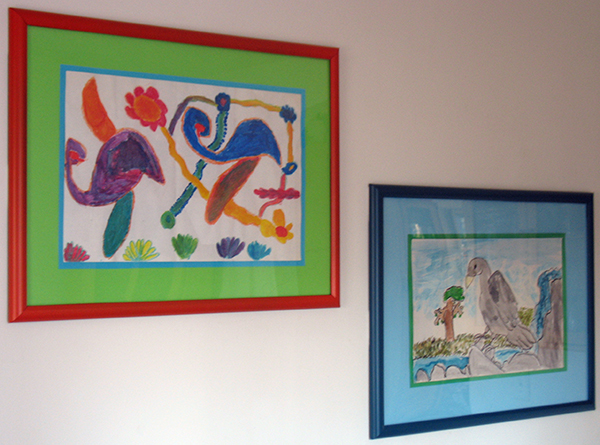
In the fall of 2020, I embarked upon a new decluttering venture, guided by Dana K. White’s book, Decluttering at the Speed of Life.
I made a lot of progress, completing a decent first pass through every room on the main floor of our house: living room, dining room, kitchen, bedroom, bath, and the fearsome-and-much-dreaded study.
I had help with the study! When my daughter returned home for winter break after her first semester in college, she was so impressed and inspired by my progress that she offered to pitch in. What a sweetheart!
The study was only half-tackled when she arrived, but it was done a mere 10 days later, and it looks great!
However, one of the things I did in the study was go through the box of artwork done by my children. It held some of their earliest work (age 2 years), as well as most of what they’d created through age 9.
Since the artwork had been sitting unseen for almost a decade, I found a lot of clarity when I looked through it. I knew what I wanted to keep, and I knew what I didn’t. I also knew what I wanted to frame and display.
Now, I could simply have set the art aside to be framed later. But I knew that if I did that another 10 years might pass in the blink of an eye. I’d already allowed too much time to pass—I’d not been enjoying the art for the whole time it sat in that box.
Plus there were the three pieces on the dining room wall with the bedraggled construction-paper frames they’d received at school. My husband and I loved the art. They deserved to be properly framed.
So, yes, I paused my decluttering to focus on art. I took an art detour! I thought I’d take you along with me. 😀
I tackled the dining room art first. Of the four pieces present, I wanted to frame three. The fourth was a crayon that had been faded by the sunlight so thoroughly that it was invisible (faded-to-white crayon on white paper).
I chose a replacement piece by my daughter from those I’d saved from the box, with the idea that I’d have two by my son and two by my daughter on the wall.
But when all four were framed, I discovered that mattes and frames together made the art MUCH LARGER. They wouldn’t all fit.
So, “Vulture Falls” by Miles Ney-Grimm and “Tropical Flight” by Rachel Ney-Grimm went up as a duo. They’re in the photo at the beginning of this post. I love that wall now—it looks so much better with the art framed.
My next focus was a set of prints created by Rachel, “Heavenly Hands” done in four variations: blue, cream, aqua, and white.
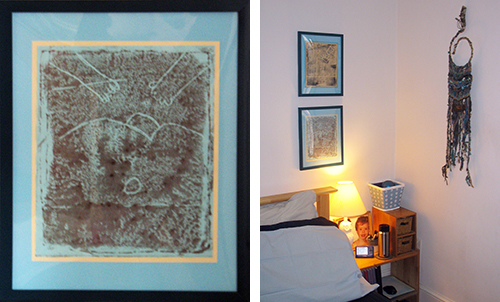
When my now-18-year-old daughter saw them, she wasn’t sure they were hers. She said, “Are you certain they’re mine? I wish they were—such a cool metaphor for deity—but maybe Miles did them.” She was happy when I showed her her own signature on the backs.
I’d imagined all four over my bedside table, but once again I’d mis-estimated the size of the framed pieces. Too large. So I put the Cream Variation and the Blue Variation in the bedroom. The White Variation and the Aqua Variation went beside the phone table in the living room.
(Yes, we still have a land line. Such boomers, as my daughter calls us, her parents.) 😀
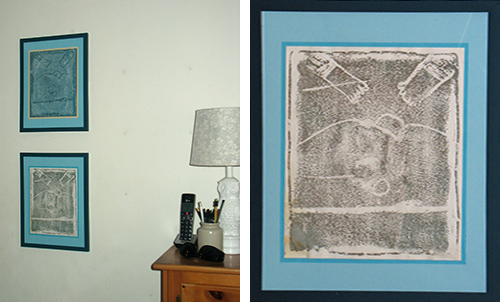
The holidays interrupted my art detour, just as the art detour interrupted the decluttering. And then getting both my children back to their respective colleges constituted yet another interruption. But I did get back to the art. (And I will get back to the decluttering.)
My son’s “Aqua Verticality” was next. It was tricky, because the yellow construction paper that served as the backing had faded, even away from light exposure in the box. I knew it would turn from yellow to a dull tan once up on the wall, just as had the old blue construction-paper frames on the dining room art.
So, at all the gaps between the painted strips of the collage made by Miles, I used an Xacto blade to cut out the fading backing. And then I re-mounted the entire assemblage on a sheet of fadeless yellow art paper. I think it turned out well.
I painted the frame. (Black frames and white frames are easy to acquire. But if you want another color…well, I suppose you could spend a boatload of money to get them. I chose to spray paint all except the two that I needed in black.)
Then I matted the piece, framed it, and hung it in our hall. I love it. I’d almost say that it is my favorite, except that I say the same thing of several of the others. 😀
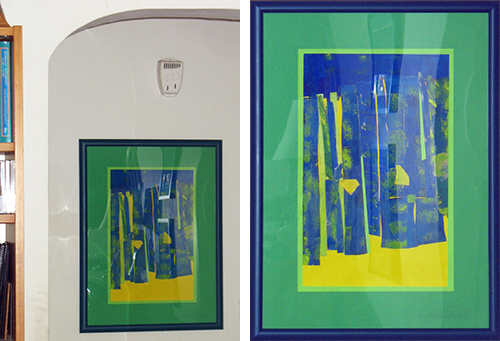
Next up were “Dragon” by Miles and “Houses,” also by Miles. They too had their tricky aspects. I’d been using fadeless art paper to create “floating” mattes, but the only fadeless paper in shades of gray came only in bulletin board sizes—4 feet by 8 feet! And the grays weren’t the right shade either.
So I decided to spray paint some of the art paper that I wouldn’t be using (such as the violet and the pink sheets). That worked really well.
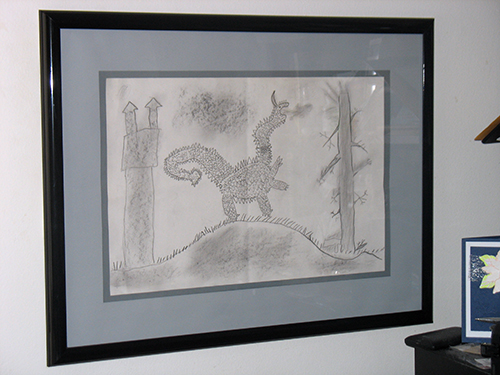
“Dragon” had been in the dining room, but it is one of my husband’s favorites (mine, too, actually), so I put it over his desk in our study.
“Houses” went on the other side of the window, over the desk that currently still holds my ancient desktop computer. My daughter helped me get the old photo files off it, so I will take it to an electronics recycling drop-off once the pandemic is over. Then that desk will become a craft/art table.
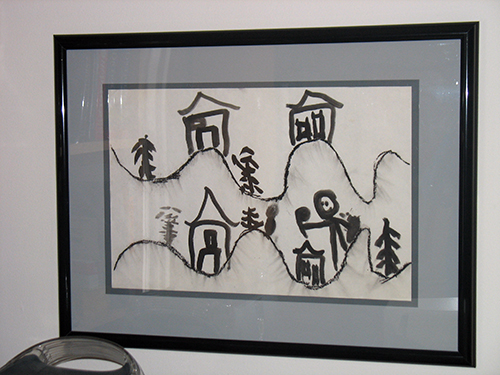
The last of the art was a print duo by Rachel. The orange variation of “House” had been in our dining room, while the gold variation lay in the box. I decided to frame the two together and put them over my main desk in our study.
First I had to take down the dozen pieces of art/reminders/affirmations that I’d generated back in 2007 while working my way through The Artist’s Way by Julia Cameron. I’d been inspired and supported by them for several years, but they were seriously old news now.
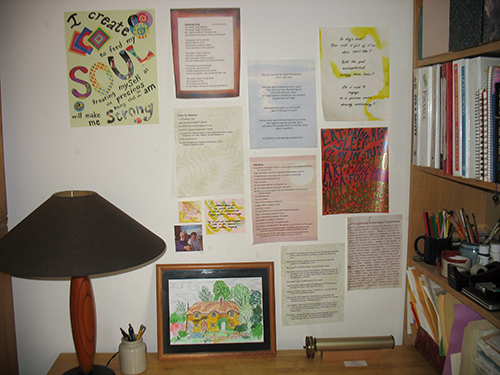
I did keep (and frame) “Soul,” as well as the watercolor (“Cottage”) and the photo portrait of my parents. But everything else is in a folder destined (eventually) for a scrapbook.
The new arrangement has “Soul,” “Cottage,” and the photo portrait grouped around “House” by Rachel.
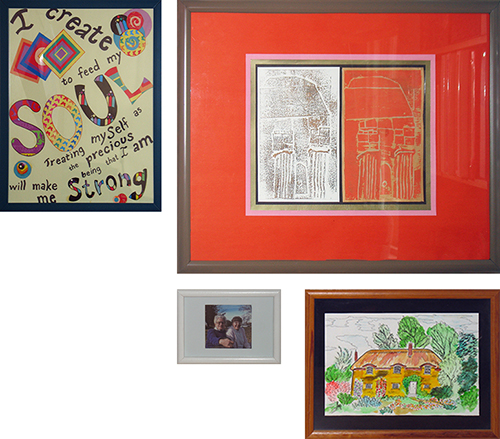
And that is the close of my art detour. It’s time to get back to writing—and decluttering.
I’ll admit that when I’m head-down in a novel, I usually neglect my house. But I am hoping to find a way to balance the two. We’ll see! And I’ll keep you posted. 😀
For more about decluttering, see:
Whole House Purge
Getting Started with the KonMari Technique
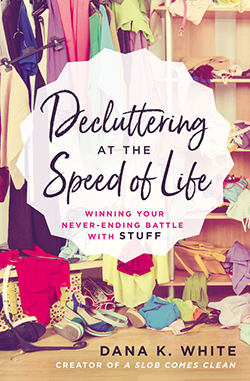 When my husband and I dropped our kids off at college in September, my first reaction was to miss them both dreadfully and feel sad.
When my husband and I dropped our kids off at college in September, my first reaction was to miss them both dreadfully and feel sad.
My second response was to dive into decluttering and cleaning my home.
I’ll admit that I became that intrusive and annoying mom who invaded her kids’ rooms to tidy up. Just for the record, they both thanked me when they returned home at Thanksgiving.
My son settled comfortably into his space, glad to be able to simply throw his clothes into his drawers and wardrobe without having to clean them out first, and to be able to set his laptop on his desk without having to make space first.
My daughter had a similar reaction to her clear closet and tidy dresser drawers, although she was more effusively verbal with her thanks.
So, yeah, they would have had a right to be mad. Except they were not, in fact, mad. They were glad.
But I digress. My real point is that cleaning their rooms is what set me off on my latest decluttering quest. I was amazed at how effective I felt in the aftermath, and I felt empowered to tackle more. I decided that I would keep going until I’d done my entire house.
Am I done now?
Well, no. But I’ve made a lot of progress. The dining room was the space I tackled next, and in the course of my work there I discovered a new book on decluttering by Dana K. White.
I’m so glad I stumbled upon Dana’s book, because I suspect I’d have stalled out without it. With it, I’ve been powering forward: kitchen, living room, bedroom, and the ever-so-dreaded study.
Are these areas perfect? No. But they are ever so much better. And as Dana says, “Better is better.”
You may remember that a few years ago I was excited about Marie Kondo’s method. I still love her method for clothes. It really worked for me, and my wardrobe and dresser drawers have remained tidy and clutter-free ever since I konmaried them.
But her method for books stopped me in my tracks. And every time I tried to detour around my books to the other three categories—paper, miscellaneous, and sentimental—I felt overwhelmed and ground to a halt quickly.
Dana K. White has gotten me past the previous road blocks. Yay! Because her approach has proven so helpful, I want to tell you about it (as well as recommending Decluttering at the Speed of Life).
She starts by introducing some general concepts. Two especially stood out for me. The first is that your house is a hard limit. It has the number of rooms that it has. It has space for a certain amount and no more. If you try to keep more in it than will fit, things will get unmanageable.
The container concept also goes for smaller containers within your home. A closet or a cupboard will contain only so much. Ditto a shelf. Ditto a drawer.
If you want to be able to move freely in your home and to easily access the physical tools of living, you need to also value open space. And you must honor the limits of your containers.
I remember once thinking that I should declutter my storage areas first, so that when I tidied the living areas I would have places to put things I wanted to store. It made logical sense, but it didn’t work. I ran out of steam quickly.
Dana explains why.
If you put in three days decluttering a storage room, you’ve just worked very hard, but you don’t see any immediate benefit in your day-to-day life. In fact, you don’t even see that beautifully clean and organized storage room, because most of your time is spent elsewhere in still-chaotic spaces that sap your energy.
When you start with the most visible areas—the most visible surfaces of the most visible room—seeing the progress energizes you to do more.
Okay, those are two of the handful of concepts Dana introduces right up front: 1) the container principle, and 2) prioritize the visible.
From there, she presents the 5-step process that you will follow again and again in each space you tackle, whether it is a shelf, a surface, a cabinet, a drawer, a corner, or a room.
In the body of her book, she discusses some of the specific challenges posed by the different kinds of spaces. I found those specifics very helpful, but I am not going to try to summarize them here. Instead I’ll describe the process that is the core of Dana’s method.
1—Trash
At the start of a decluttering session, start with the easiest of the easy stuff: trash.
You may think that there isn’t any, but you will be wrong.
In a pile of paper, there will be expired sales offers or scraps. In the pantry, there will be empty or almost-empty bags or boxes of stale food. In the coat closet, there will be mittens missing a mate. In the living room, there will be packaging from the bird feeder you ordered and set up in the yard.
Throw the trash in the trash bin or the recycle bin. The space will feel better immediately, and you will get a little burst of energy from it.
2—Easy
Look for items that belong somewhere else and that have a home. Take them there straight away.
Yes, you can glance around to see if there is something else that belongs in the same place. No, don’t hunt. Just grab anything obvious and go. Yes, you will be getting a lot of exercise this way. But there is a reason to do the putting-away-of-easy-stuff in this less efficient way.
When you get interrupted, you don’t leave a mess behind. The trash has gone directly into the trash/recycle. These easy items have been put away. You leave the space better no matter what.
3—Donate
Next look for items that are obvious donatables.
These are the things that make you think, “Why on earth do I have that?” or “Why in the world did she give me that?” or “Yikes! I don’t want that in my home!”
Put them into a donatable box or bag.
If you fill up the box/bag, take it out to your car straight away and get a fresh container as you continue to declutter.
These first three steps will reduce the mass quite a bit. Sometimes that spot—shelf, surface, corner—will be done. All that remains there will be things that you want to live there. But if some problem items remain…
4—Ask the 2 Decluttering Questions
• If I needed this item, where would I look for it first?
Not: where would I or should I stash it? Not: where would this logically go. No.
Where would you actually look for it?
If you have an answer to this question, take it there straight away. If you have no automatic answer, ask the second decluttering question.
• If I needed this item, would I even remember I had one?
If you wouldn’t remember, if you’d assume you would have to buy or borrow one, put it in the donate box. It’s clutter if you wouldn’t pull it out to use it, and it does you no good at all to hang onto it.
5—Make It Fit
This is where the container principle comes to the fore. The shelf is the size that it is. The drawer is the size that it is. After steps 1 — 4, the items you have left all belong here. Do they fit?
If they do, you’re done with this space.
But if they don’t, you’ll need to decide which ones to keep and which ones to discard.
To help you decide, put like with like.
Put all the sauce pans together. Which ones are your favorites? Donate the one that is always too big for making the stir-fry sauce, but too small making tomato soup. Or, if you use and love all four, look for a frying pan or a stock pot that you never use to discard. Something has to go, because the space you have for pots is the space you have for pots.
And there you have it.
I have found that going after trash breaks my log jam of overwhelm. Once I’m moving, it’s pretty easy to identify things to donate.
I have a little more difficulty with easy things that have a home, because I tend to be good at putting things away. If I encounter something that is not put away, it’s usually because the place it goes is too full.
Dana says that when this happens, identify something in the home-spot that is less worthy of keeping than the item you are trying to put away. This is logical, and clearly works for her.
But I have found that the home-spot usually is a decluttering project all on its own. And I know that abandoning the spot where I’m decluttering to tackle this new spot is a recipe for disaster. Luckily I haven’t encountered this situation too often.
Sometimes I can do the one-in-one-out dance. Otherwise I place the loose item on top of the shelf unit or cabinet where it goes. Obviously, if this happened a lot, I’d be making a bigger mess or else just shifting the mess.
But, so far, I’m generating huge piles of bags containing donations and recycling, and getting them out of the house.
Using Dana’s process has generated an attitude shift in me.
I’m no longer asking myself, “Is this a useful item?”
As she points out, creative people can always come up with a good way to use most things. So anything can look useful to me.
The better consideration for me is: Do I have a specific plan to use this? Or a specific occasion or a specific time?
 So when I encountered a “tapestry” art project in my study, I considered. Was I really going to finish it? Did I still love it or was I over it? When would I finish it?
So when I encountered a “tapestry” art project in my study, I considered. Was I really going to finish it? Did I still love it or was I over it? When would I finish it?
Well, I did still love it. I couldn’t bear the idea of throwing it out. But I didn’t want to let it sit on top of the project shelves gathering dust. So I scrutinized it with an eye to making a definite plan to finishing it.
I was astonished to discover that I needed only to fasten three remaining horizontal stands and attach the bronze piece I intended to place at the top of the fringe. So little! How had I let it sit unfinished for 13 years?!
I put the task on my immediate to-do list, and had it done within the week. Now it is hanging on my wall and I feel happy every time I set eyes upon it.
I used the same mindset when I tackled the box of kids’ art that I’d saved with the intention of framing some of it and hanging it. With each piece, I considered whether I really intended to frame and hang that one. Most of the art went into the recycle bin. But I did save a dozen. And I ordered framing materials for four of them immediately.
Not everyone will have art as the category of things that will acquire greater clarity through action. But I suspect many of us have something.
If it is clothes, make yourself wear the items your usually don’t wear. If it is cooking gear, make some meals using the unused stuff. If it is coffee mugs, drink from them. If it is books, start reading your way through the books you haven’t read in years.
It will soon become clear which items you really do want to keep and which items you really don’t want to keep.
Dana has lots of tips regarding specific spaces in your home. The kitchen has some challenges unique to it. Ditto hobby rooms. Ditto closets. If you want new energy and inspiration to do some decluttering, I highly recommend you get her book, Decluttering at the Speed of Life.
In the meantime, I’ll report in with my own progress in decluttering from time to time. I’d love to hear about yours, if you feel inclined to share. 😀
For more on decluttering, see:
Getting Started with the KonMari Technique
In the middle of May, I became convinced I should be growing some vegetables. Whether this conviction were truly wise…I remain uncertain. Regardless of the wisdom of the plan, I set about gathering supplies.
The middle of May is certainly leaving it late. And supplies were thin on the ground. Furthermore, finding a suitable spot in our yard was problematic.
Twenty years ago, there was plenty of sun in the front yard. Since then, our cherry blossom tree has grown considerably and the only sunny area is on our front deck.
The back yard has a similar problem. Once sunny, now the maple trees are so tall that it is shady. Even if there were a sunny patch, the herd of deer that regularly roam through would munch any vegetables grown there.
Despite these difficulties, I persevered. We obtained three box planters and set them up on the front deck!
Getting seeds was a challenge as well, and I think I ordered the very last packets that Park Seed had in stock!
But it has all come together and I wanted to show you what I have growing.
Here is my plan for the planter next to my front door.
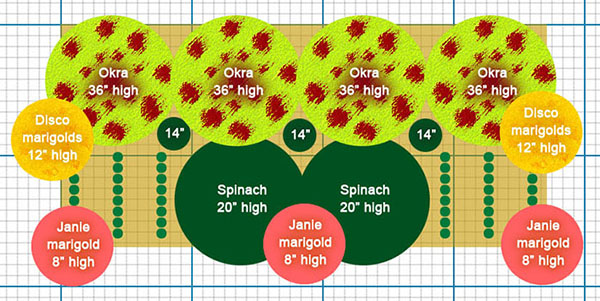
As is often the case, my plan had to adjust once reality hit. When the bare root strawberries arrived, there were 26, six more than the 20 I’d ordered. There was no way I’d toss the extras. I mean, strawberries! I had to find a place for them. So I popped them into the okra bed.
Also, the spinach never germinated. Zip. Bare soil. So I sowed more lettuce there. (Those small green dots all represent lettuce.) It would be too late for lettuce (which bolts in the heat), if I were growing full heads. But I’m doing cut-and-come-again. So I think I’ll get to harvest some before the heat gets it.
Here’s a photo of the “okra bed.” Isn’t it pretty!
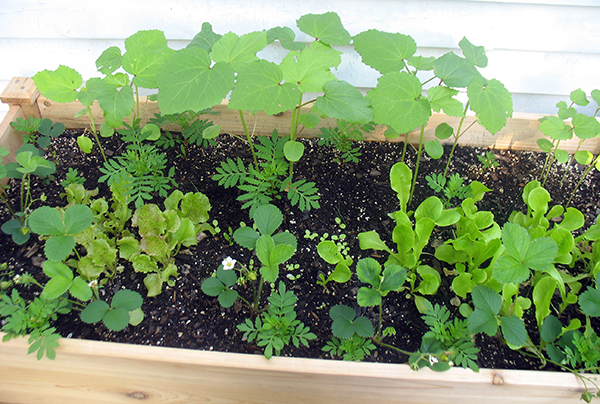
The planter next to the “okra bed” is the “pepper bed.” Originally I thought of it as the “basil bed.” It does have basil in it, but we added a pepper plant when we discovered a local source with curbside pick-up. That pepper plant is so beautiful that it rather overshadows the basil, which is still quite small.
Here is my plan for the “pepper bed.”
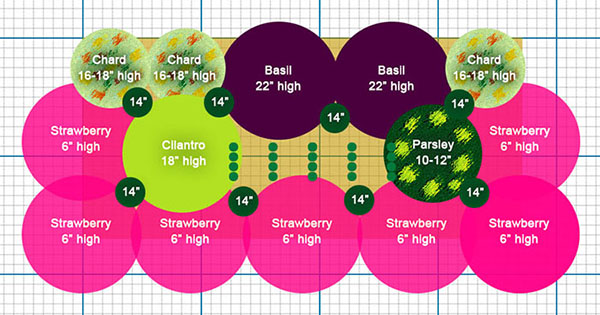
Reality also forced some changes to this bed. Not only did the pepper replace some of the chard, but the lettuce and parsley never came up. So when I thinned the basil, I moved the seedlings to fill those spaces.
Here’s a photo of the “pepper bed.” That tall plant at the left is the pepper! 😀
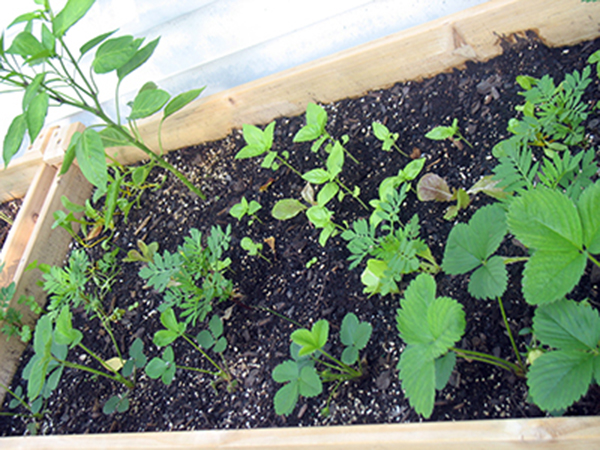
At the far end of the deck, past the “pepper bed,” is the “beet bed.” The “beet bed” has remained closest to its plan, but not identical. Here’s the plan.
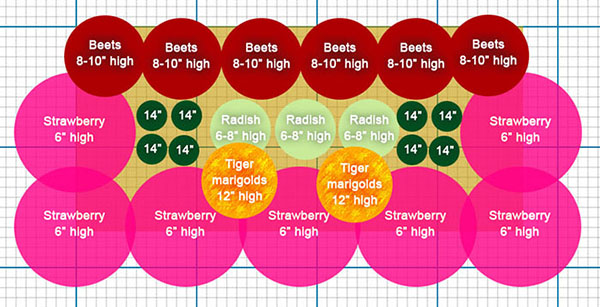
The radishes all moved to the right side of the middle space, while the left side became home to more lettuce, and the green onions were dotted here and there. Here’s a photo of the lettuce side.
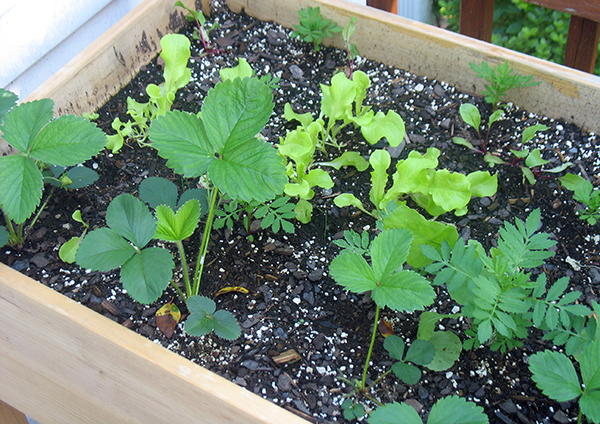
My daughter has been helping me with this mini vegetable garden, and it’s been a lot of fun. Plus it sparked the whole family to renewed fervor for yard work. I’ve enjoyed our time with the four of us all working together. And I really like the beauty emerging from the jungle that our yard had become.
 We just harvested our first radish this morning!
We just harvested our first radish this morning!
As a family project, it’s been a total success.
As a significant addition to our food supplies…not so sure. It’s early days yet, of course. I expect the okra will be the biggest producer, and that will reach harvest much later in the summer. It will be nice to have fresh basil. And the strawberries, fresh from the garden, will be lovely.
But so far, we’ve had enough lettuce for a few salads, and that’s it.
And yet, I don’t regret having put my energy into this. I’m learning new things, which I always love. And the family fun is priceless!
I started blogging February 2012.
I can still remember my uncertainty at the time. Would I be able to dream up interesting topics week after week? Would any readers find my blog? Would I make it past the 3-year mark that is the end point for so many bloggers?
I really didn’t know how blogging would go for me.
But I discovered that I loved it.
So here we are…this is my 500th post! Celebrate with me and leave a comment. I’d love to hear from some of you, especially if you’ve been following along for a while. Or if you’re new. Give me a shout and say hello! 😀
 The last time anyone from Casa Ney-Grimm set foot in a grocery store was sometime during the second week of March. It’s been delivery or curbside contact-free pick-up ever since.
The last time anyone from Casa Ney-Grimm set foot in a grocery store was sometime during the second week of March. It’s been delivery or curbside contact-free pick-up ever since.
Food supplies have been good. TP? Not so much. In fact, not at all.
At first I wasn’t too worried. But as we watched our stash of toilet paper go down and down and down over the weeks, I wondered where the end of it would be.
Would we have to venture into the store to get any? I really didn’t want to do that, given that my husband occupies three of the high risk categories.
I searched on Amazon and discovered a bale of 12 rolls that would arrive sometime between April 23 and May 15.
The reviews were poor. The rolls were scant and the paper itself thin, harsh, and prone to ripping.
But I figured it would be better than nothing at all, so I ordered it.
Then I watched our existing stock of TP go down some more. Even if the Amazon order arrived on April 23, it was going to be close. If it arrived in mid-May…we weren’t going to make it.
So I decided to search for the commercial rolls that are massive in size and don’t fit on home dispensers. We might have to prop a drum on the side of the tub, but at least we’d have something!
I found a bale of the commercial TP that was reasonably priced, had good reviews, and possessed a delivery date range of April 23 to May 1.
My husband eventually broke out the 3 rolls of camping TP stashed in a backpack. And we made it! Just barely. (One roll of camping TP left.)
I was pleasantly surprised with the quality of the commercial TP. It’s soft, cushiony, and strong—much better than everything I’ve encountered in public restrooms.
As you can see in the photos above, we decided to roll the TP from one gigantic commercial roll onto the multiple cardboard tubes we’d been saving for that purpose. The first attempted transfer (roll on the far right) was…messy! But we got more skillful with practice.
Ironically, a mere 3 days after the colossal bale arrived from Amazon, our grocery store had TP available for delivery. Just one package per order, but still. We ordered it, and it arrived. After coming so close to having none, I’d rather have a little extra now!
For more on how we’re coping during the pandemic, see:
Exercise in the Time of Coronavirus
Conquering Back Pain
Tackling Hip Pain